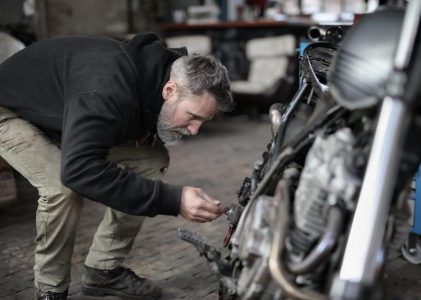Understanding the Benefits of the Swap
Converting your 240SX from automatic to manual enhances performance, control, and driving engagement․ It improves acceleration, fuel efficiency, and driver involvement, making it a cost-effective upgrade for enthusiasts seeking a more dynamic experience․
Why Convert to Manual Transmission?
Converting your 240SX to a manual transmission offers numerous benefits, including improved performance, better control, and a more engaging driving experience․ Manual transmissions typically provide faster acceleration and sharper throttle response compared to automatics, making the car feel more responsive and agile․ Additionally, manual transmissions are often more fuel-efficient, especially for drivers who frequently navigate hilly or winding roads․ Beyond performance, many enthusiasts appreciate the connection and control that comes with shifting gears, enhancing the overall driving enjoyment․ For those planning future modifications, a manual transmission is often a foundational upgrade that maximizes the effectiveness of other performance enhancements․ This swap is particularly popular among 240SX owners seeking to unlock their car’s full potential․

Assessing Suitability
Assessing suitability for a manual swap involves considering model year, compatibility of parts, and mechanical aptitude․ Ensure your 240SX is a candidate for a seamless conversion․
Model Year Considerations
When planning an auto-to-manual swap for your 240SX, model year plays a crucial role․ The S13 (1989-1994) and S14 (1995-1998) are the most common candidates for conversion․ Early models often have fewer electrical complexities, making the swap more straightforward․ Later models, such as the S15, may require additional adjustments due to advanced electronics․ Ensure your vehicle’s specific year aligns with the parts and tools you source․ Compatibility of components like the transmission, driveshaft, and wiring harness varies across model years․ Researching your 240SX’s generation will help identify potential challenges and ensure a smoother process․ Understanding these differences is key to a successful swap․
Gathering Necessary Parts
Key components include a compatible manual transmission (M20, M21, M22), clutch kit, flywheel, driveshaft, transmission mounts, and wiring harness․ Ensure all parts are specific to your 240SX model year․
Manual Transmission Options
For a 240SX swap, popular manual transmission choices include the Nissan M20, M21, and M22 units․ The M20 is a 5-speed option, known for its durability and smooth shifting, making it ideal for daily drivers․ The M21, another 5-speed variant, offers slightly improved performance characteristics and is often preferred by enthusiasts seeking a balance between drivability and sportiness․ The M22, also a 5-speed, is recognized for its strength and is commonly used in high-performance builds․ Each transmission has specific compatibility requirements, so selecting the right one depends on your car’s model year and intended use․ Ensuring compatibility with your 240SX’s engine and drivetrain is crucial for a seamless swap․
Clutch and Flywheel
The clutch and flywheel are critical components in a manual transmission swap․ A high-quality clutch kit, including the clutch disc, pressure plate, and release bearing, ensures smooth and precise shifting․ The flywheel must be compatible with the manual transmission and clutch setup, often requiring resurfacing or replacement for optimal performance․ Proper alignment and installation of these components are essential to avoid wear and tear․ Upgrading to a lightweight flywheel can improve acceleration and throttle response, while a performance clutch offers better grip for high-torque applications․ Always ensure compatibility between the clutch and flywheel to maintain proper engagement and disengagement․ These components are vital for a smooth transition from automatic to manual operation․
Driveshaft and Other Components
The driveshaft must be shortened and adapted to accommodate the manual transmission, as automatic and manual transmissions have different spline counts and lengths․ A compatible driveshaft is essential for proper power delivery․ Additionally, other components such as the shifter assembly, transmission mount, and crossmember must be installed or modified to support the manual transmission․ The speed sensor from the automatic transmission can often be reused, but it must be compatible with the manual setup․ Ensuring all components are properly aligned and installed is critical for smooth operation․ These modifications require careful planning and consultation with guides or forums to avoid costly mistakes․ Properly adapting these components ensures reliability and optimal performance post-swap․
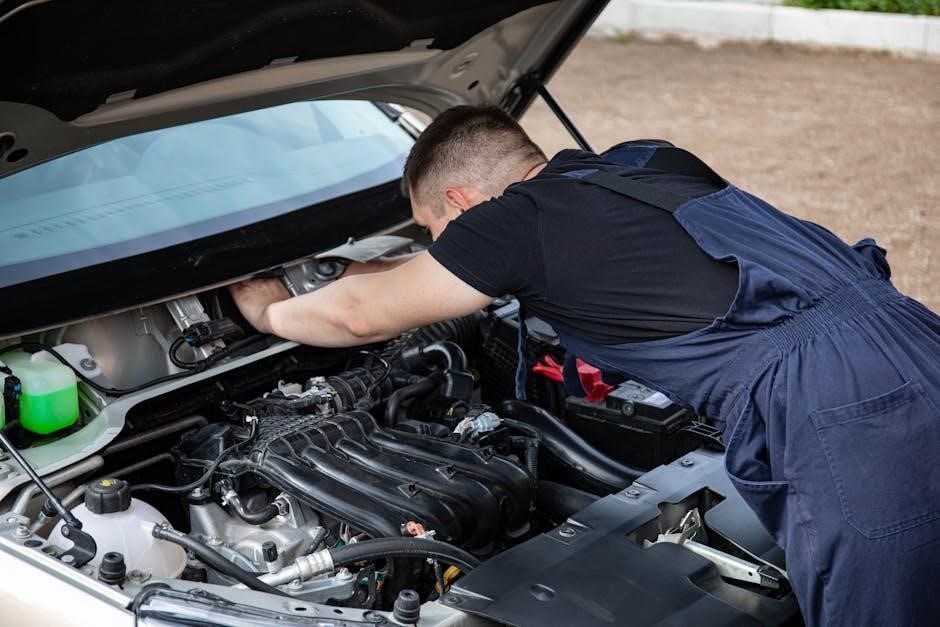
ECU and Wiring Adjustments
ECU reprogramming is essential to recognize the manual transmission, ensuring proper engine operation․ Wiring modifications may include installing a clutch pedal switch and adjusting transmission sensors for compatibility․
Understanding ECU Requirements
When converting your 240SX from automatic to manual, the ECU must be reprogrammed to recognize the manual transmission․ This ensures proper engine operation and prevents issues like incorrect gear readings or limp mode․ The ECU adjustments involve recalibrating the transmission control module to align with the manual setup․ Additionally, wiring modifications are necessary to integrate components like the clutch pedal switch and manual transmission sensors․ The speed sensor from the automatic transmission can often be reused, but its wiring may need to be adapted․ Proper ECU configuration is critical for smooth operation, and incorrect settings can lead to drivability problems․ Consult detailed guides or forums for specific wiring diagrams and reprogramming steps to ensure accuracy․
Wiring Modifications
Wiring modifications are essential when converting your 240SX from automatic to manual․ The automatic transmission harness must be adapted to accommodate the manual setup, including the clutch pedal switch and reverse light switch․ The speed sensor from the automatic transmission can typically be reused, but its wiring may need to be rerouted or spliced․ Additionally, the transmission control module (TCM) must be reconfigured or removed, as it is no longer needed with a manual transmission․ Proper wiring ensures smooth communication between the ECU and the manual transmission components․ Detailed wiring diagrams and step-by-step guides are available online to help navigate this process․ Careful planning and precision are critical to avoid electrical issues or system malfunctions after the swap․
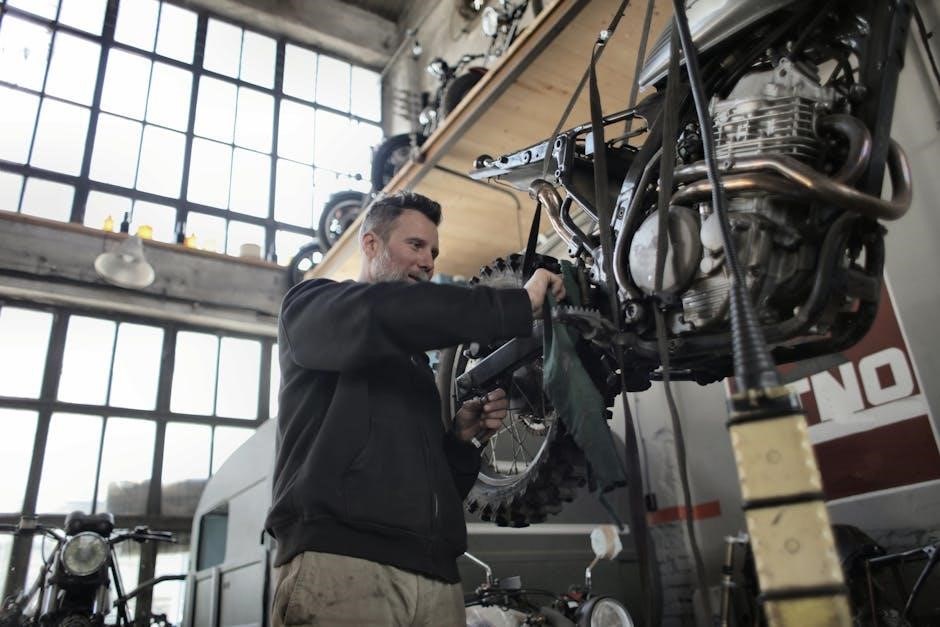
Installation Process
The installation involves removing the automatic transmission, fitting the manual unit, and aligning components like the driveshaft and clutch pedal․ Proper tools and alignment are crucial for success․
Removing the Automatic Transmission
Removing the automatic transmission is a critical step in the conversion process․ Begin by draining the transmission fluid and disconnecting the battery to prevent any electrical issues․ Lift the car securely and remove the driveshaft, taking care not to spill remaining fluid․ Disconnect the electrical connectors and transmission cooler lines, then unbolt the transmission mount and crossmember․ Use a torque wrench to loosen the transmission bolts, working in a star pattern to avoid warping the casing․ Finally, carefully pull the transmission straight out, ensuring it does not damage surrounding components․ Have a helper or transmission jack ready to support the unit during removal․ Proper tools and organization are essential for a smooth process․
Installing the Manual Transmission
Installing the manual transmission requires precision and care․ Align the transmission with the engine’s bellhousing, ensuring the input shaft engages the clutch properly․ Use a transmission jack or helper to guide it into place․ Bolt the transmission to the engine, tightening in a star pattern to avoid misalignment․ Reattach the driveshaft, ensuring it is securely connected․ Reinstall the transmission mount and crossmember, adjusting for proper clearance․ Connect the electrical connectors and manual transmission-specific wiring harness․ Bleed the clutch system to remove air bubbles and ensure smooth pedal operation․ Double-check all connections and bolts for tightness before lowering the car․ Proper installation ensures smooth operation and longevity of the transmission․
Clutch Pedal Installation
Clutch pedal installation is a critical step in the manual swap․ Begin by removing the automatic pedal assembly and any associated wiring or brackets․ Install the manual pedal assembly, ensuring it is securely bolted to the firewall or designated mounting points․ Connect the clutch master cylinder to the pedal, aligning it properly to avoid misalignment․ Attach the clutch slave cylinder to the transmission and connect the hydraulic line․ Bleed the system thoroughly to eliminate air and ensure proper fluid flow․ Adjust the pedal height and free play according to manufacturer specifications for optimal feel and performance․ Finally, test the pedal operation to ensure smooth engagement and release of the clutch․
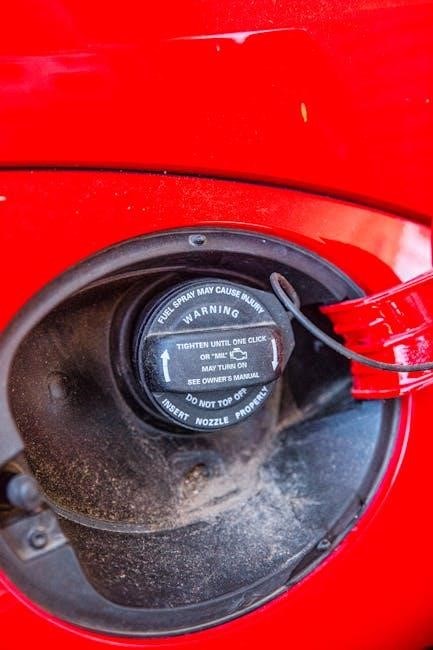
Post-Swap Testing and Troubleshooting
After the swap, conduct a thorough test drive to check for smooth shifting and proper clutch engagement․ Monitor for any unusual noises or vibrations․ Troubleshoot issues like slipping gears, fluid leaks, or electrical malfunctions promptly to ensure reliability and performance․
Initial Test Drive
After completing the manual swap, begin with a cautious initial test drive in a safe, open area to assess the transmission and clutch performance․ Start by checking smooth shifting through all gears, ensuring proper engagement and no grinding or hesitation․ Monitor the clutch pedal feel, making sure it engages and disengages smoothly․ Pay attention to any unusual noises or vibrations, as these could indicate issues with the installation․ Test acceleration from a standstill and shifting under load to verify proper operation․ If everything feels right, gradually increase speed, ensuring the car responds predictably․ Address any concerns immediately to avoid potential damage․ A successful test drive confirms the swap’s success and readies the car for everyday use․
Troubleshooting Common Issues
Common issues after a 240SX manual swap include clutch noise, difficulty shifting gears, or a dragging clutch․ These often stem from improper clutch alignment or incorrect adjustment․ If the clutch pedal feels spongy or doesn’t engage fully, check the hydraulic system for leaks or air in the lines․ Grinding gears may indicate misaligned shifter components or improper synchro engagement․ Inspect the shift linkage and ensure it’s securely connected to the transmission․ A dragging clutch could result from incorrect pedal adjustment or a faulty release bearing․ For persistent issues, verify the transmission fluid level and consider bleeding the clutch system to ensure proper operation․ Addressing these problems promptly prevents further damage and ensures smooth functionality․ Regular inspection of components can help identify and resolve issues early, maintaining the car’s performance and reliability․

Considerations and Costs
Converting a 240SX from automatic to manual involves significant costs for parts like transmission, clutch, and wiring․ Plan for labor expenses if professional help is needed, balancing initial investment with long-term performance gains․
Estimating Costs
Estimating costs for a 240SX auto-to-manual conversion requires careful planning․ The manual transmission itself can range from $500 to $1,500, depending on the model and condition․ A clutch and flywheel kit typically costs between $300 to $600․ The driveshaft may need replacement or modification, adding another $200 to $400․ Wiring harness modifications and ECU adjustments can range from $100 to $300․ Additional costs include transmission fluid, clutch lines, and other hardware․ Labor costs vary widely, with professional installation ranging from $800 to $1,500․ Hidden costs, such as potential transmission rebuilds or unforeseen repairs, should also be considered․ Overall, the total cost can range from $2,000 to $5,000, depending on the extent of the swap and whether you tackle it yourself or hire a mechanic․
Hidden Costs
Beyond the initial parts and labor, hidden costs in a 240SX auto-to-manual swap can arise․ These include modifications to the driveshaft or axle, potentially costing $200 to $400․ If the transmission requires rebuilding, this can add $500 to $1,000․ Some swaps may need a new clutch slave cylinder or master cylinder, costing around $100 to $200 each․ Additionally, alignment or suspension adjustments post-swap can add $100 to $300․ Brake systems may also need upgrading to handle increased performance, costing between $300 to $600․ Lastly, unexpected repairs, such as replacing worn-out bushings or bearings, can add another $150 to $300․ These unforeseen expenses highlight the importance of thorough planning and budgeting for a successful swap․

Maintenance Post-Swap
Regular transmission fluid changes, clutch inspections, and drivetrain checks are essential to ensure optimal performance and longevity after the swap․
Transmission Fluid
Regularly changing the transmission fluid is crucial for maintaining smooth gear shifts and extending the life of your manual transmission․ Use the recommended high-quality fluid specified for your 240SX’s manual transmission to ensure optimal performance and protection against wear․ Replace the fluid every 30,000 to 60,000 miles, depending on driving conditions․ Old fluid can become contaminated and lose its lubricating properties, leading to premature wear on internal components․ Always check the manufacturer’s guidelines for the correct fluid type and change interval․ Proper maintenance will help prevent costly repairs and keep your transmission running smoothly for years to come․
Clutch Maintenance
Proper clutch maintenance is essential for smooth operation after a manual swap․ Regularly inspect the clutch and flywheel for wear or damage․ Ensure the clutch pedal operates smoothly, with the correct free play and engagement point․ Bleed the clutch system annually or if you notice spongy pedal feel․ Inspect the clutch slave cylinder for leaks and replace it if necessary․ The clutch should last between 50,000 to 100,000 miles with proper care․ Avoid riding the clutch, as this can cause premature wear․ If you notice slipping, chatter, or difficulty shifting, address the issue promptly to prevent costly repairs․ Regular maintenance ensures optimal performance and extends the life of your clutch system, keeping your manual transmission running smoothly and efficiently․
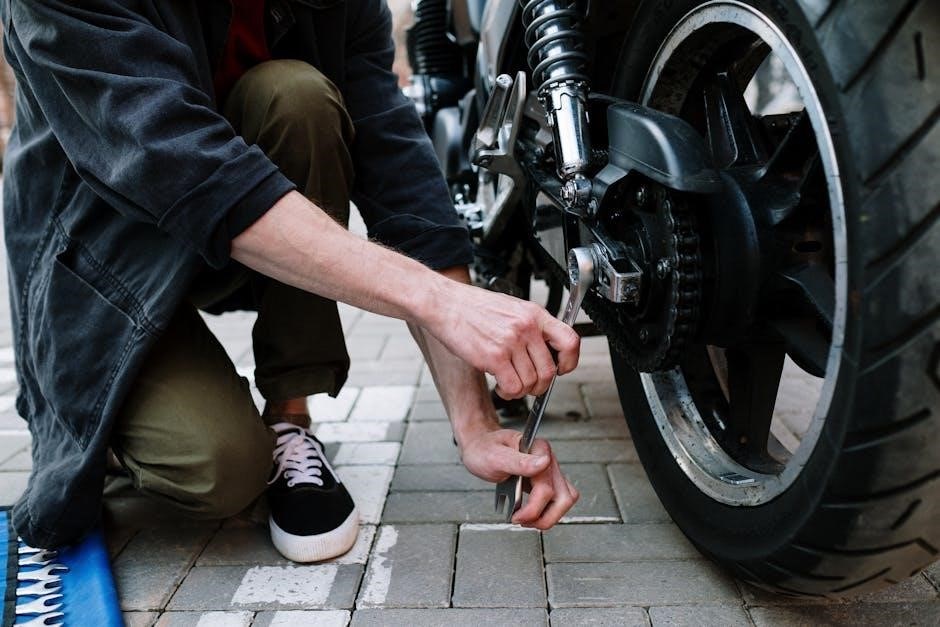
Community and Resources
Join forums, social media groups, and websites like NicoClub or Reddit for support, tutorials, and expert advice․ Engage with enthusiasts to share experiences and troubleshoot challenges․
Joining Communities
Video Tutorials
Video tutorials are an essential resource for a 240SX manual swap․ Channels on YouTube offer detailed step-by-step guides, covering everything from removing the automatic transmission to installing the manual components․ Videos provide visual instruction, making complex tasks like wiring modifications and clutch pedal installation easier to understand․ Many creators share their personal swap experiences, highlighting common challenges and offering practical solutions․ For example, channels like PATROL GQ and Ninjonaah have comprehensive playlists dedicated to the 240SX swap, offering real-time footage and expert tips․ These tutorials are particularly helpful for visual learners, ensuring a smoother and more confident conversion process․
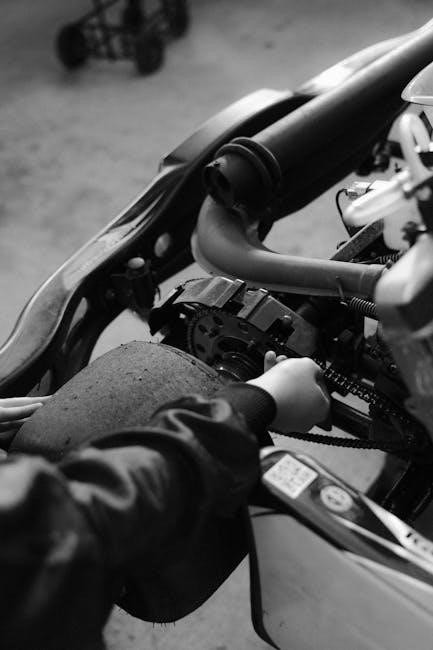
Planning and Preparation
Planning and preparation are crucial for a smooth conversion․ Create a detailed checklist, gather necessary tools, and understand the timeline to avoid delays․
Creating a Checklist
A comprehensive checklist is essential for a successful auto-to-manual conversion in your 240SX․ Start by listing all necessary parts, such as the manual transmission, clutch, flywheel, driveshaft, and ECU components․ Include tools like wrenches, screwdrivers, and transmission-specific tools․ Plan your workspace and timeline to ensure a smooth process․ Research and note transmission options (e․g․, M20, M21, M22) and ensure compatibility․ Don’t forget to prepare for wiring modifications and clutch pedal installation․ Organize your checklist by priority and category to avoid missing critical steps․ Finally, double-check online guides to ensure no details are overlooked․ A well-prepared checklist will help you stay organized and confident throughout the conversion․
Time Management
Effective time management is crucial for a successful 240SX auto-to-manual conversion․ Allocate sufficient time for each step, as rushing can lead to errors․ Plan for a realistic timeline, considering weekends or days off for major tasks like transmission removal and installation․ Break the process into stages: preparation, part sourcing, and actual installation․ Allow extra time for unexpected issues, such as wiring complexities or clutch alignment․ Avoid underestimating the time required for ECU adjustments and troubleshooting․ A well-planned schedule ensures a smoother conversion and reduces frustration․ Prioritize tasks, focus on one step at a time, and maintain patience throughout the process․ Proper time management is key to achieving a seamless and enjoyable swap experience․

Tool Preparation
Gather essential tools: socket set, wrenches, screwdrivers, and specialized tools like a clutch alignment tool and transmission jack․ Ensure everything is organized for efficiency and safety․
Necessary Tools
To successfully perform an auto-to-manual conversion on your 240SX, you’ll need a variety of tools․ Start with basic tools like a socket set, wrenches, and screwdrivers․ A transmission jack is essential for safely removing and installing the transmission․ Specialized tools, such as a clutch alignment tool, will help ensure proper installation of the clutch and flywheel․ Additionally, a set of punch marks or a slide hammer may be needed for removing old parts․ Don’t forget a drain pan for fluid changes and gloves for protection․ Organize your tools beforehand to streamline the process․ Having the right tools on hand will save time and reduce frustration during the swap․ A comprehensive tool set ensures you’re prepared for every step of the conversion․
Converting your 240SX to manual offers enhanced driving engagement and performance․ Ensure you have the right tools, parts, and knowledge for a smooth swap․ Plan meticulously, seek community support, and enjoy the improved driving experience․
Final Thoughts
Converting your 240SX from automatic to manual is a rewarding project that enhances performance and driving satisfaction․ It requires careful planning, research, and patience but offers a sense of accomplishment and improved control․ By following detailed guides, seeking community support, and ensuring proper installation, you can achieve a seamless swap․ The end result is a more engaging and dynamic driving experience, making the effort well worth the time and resources invested․ Remember to enjoy the journey, as the process is as valuable as the outcome․ With the right preparation and dedication, your 240SX will transform into a vehicle that delivers both thrill and precision on the road․

